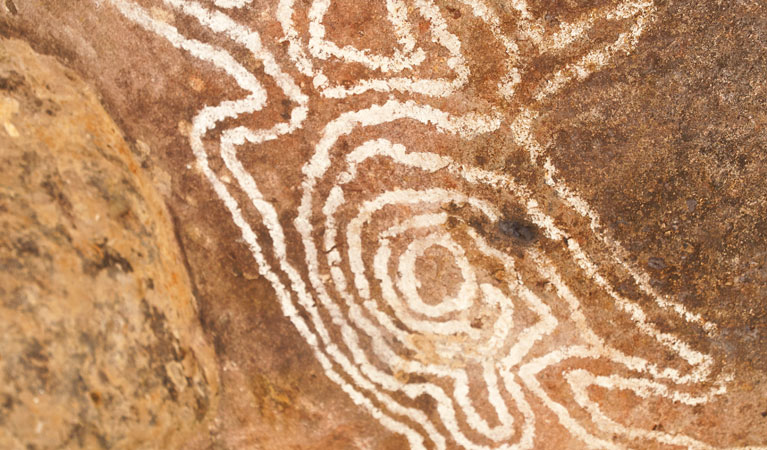Yapa (Mulgowan) Aboriginal art site walking track
Gundabooka National Park
Open, check current alerts
Overview
Yapa (Mulgowan) Aboriginal art site walking track offers a unique Outback experience with Aboriginal rock art and birdwatching in Gundabooka National Park, near Bourke.
- Where
- Gundabooka National Park in Outback NSW
- Distance
- 1.4km return
- Time suggested
- 45min - 1hr 15min
- Grade
- Grade 5
- What to
bring - Hat, drinking water, sunscreen
- Please note
- This park or attraction is in a remote location and weather can be unpredictable, so please ensure you’re well-prepared, bring appropriate clothing and equipment and advise a family member or friend of your travel plans.
For an outback adventure that’s bound to inspire, head for Yapa (Mulgowan) Aboriginal Art site walking track in Gundabooka National Park, near Bourke. Be amazed by the fascinating Aboriginal rock art of the Ngemba and Paakandji people, set amongst unspoilt bushland. It’s an unforgettable ‘off the beaten track’ experience for all ages.
Following this challenging yet rewarding walking track along encompassing boulders, you might see hooded robins and pink cockatoos. Arriving at the enormous rock overhang, you’ll discover unique Aboriginal rock paintings that not only depict animal motifs, but dancers, hand stencils and hunting tools. The surrounding Gunderbooka Range and Mulareenya Creek is a significant area where ceremonies were held and the echoes of a vibrant Aboriginal culture can still be felt.
Take your time to soak up the tranquil setting before retracing your steps. If you’re keen to explore, try Bennetts Gorge picnic area and the nearby walk or pitch your tent beneath the vast desert sky at Dry Tank campground or Yanda campground.
Take a virtual tour of Yapa (Mulgowan) Aboriginal art site walking track captured with Google Street View Trekker.
Also see
-

Yapa (Mulgowan) art site picnic area
Yapa (Mulgowan) art site picnic area is in Gundabooka National Park at the start of Yapa (Mulgowan) art site walking track. Rest in the shade before a short, challenging walk to this Aboriginal site.
-

Yapa (Mulgowan) art site lookout
Yapa (Mulgowan) art site lookout is in Gundabooka National Park near Yapa (Mulgowan) art site walking track. Visit this viewing platform to see ancient Aboriginal rock paintings.
Map
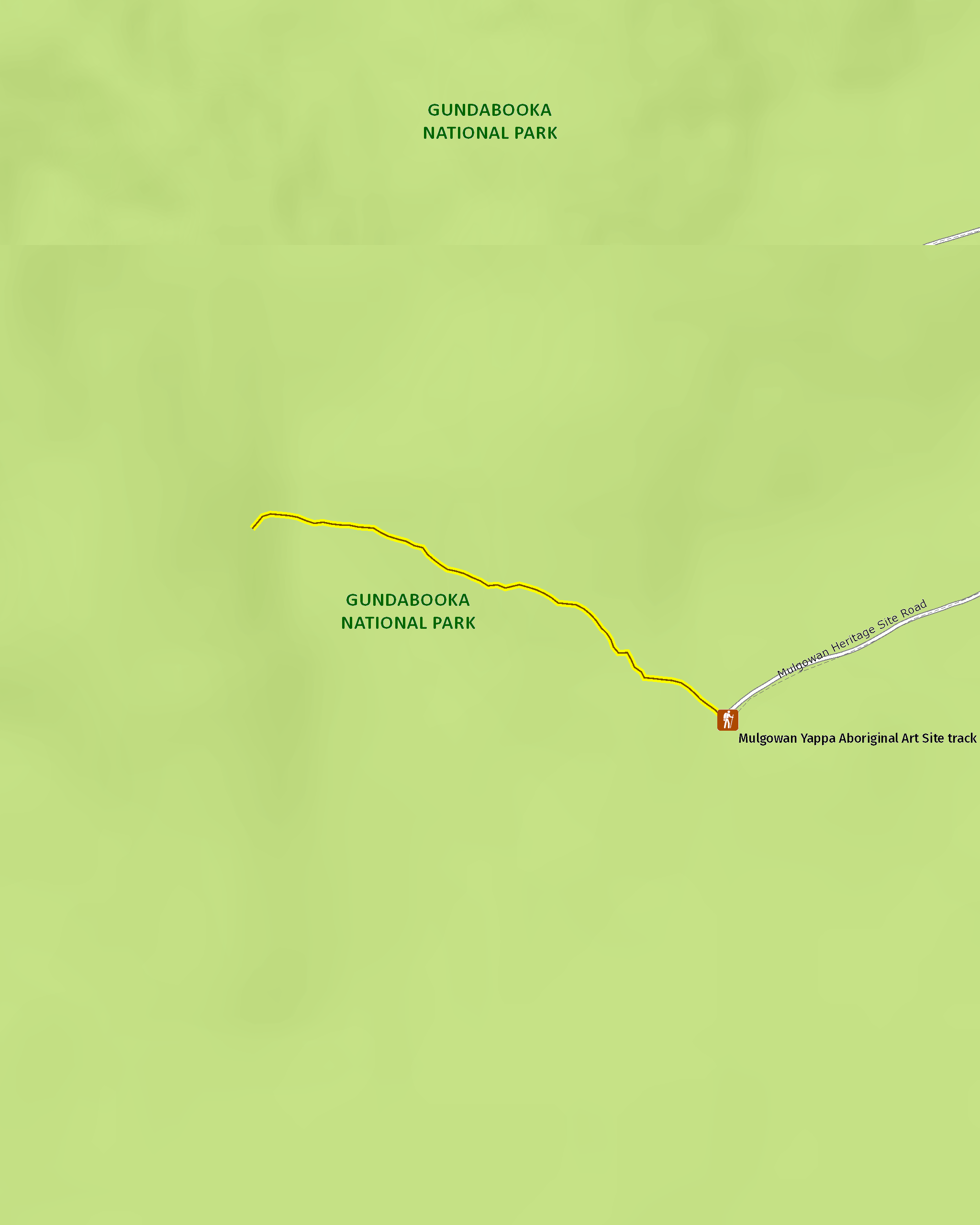
Map legend

Map
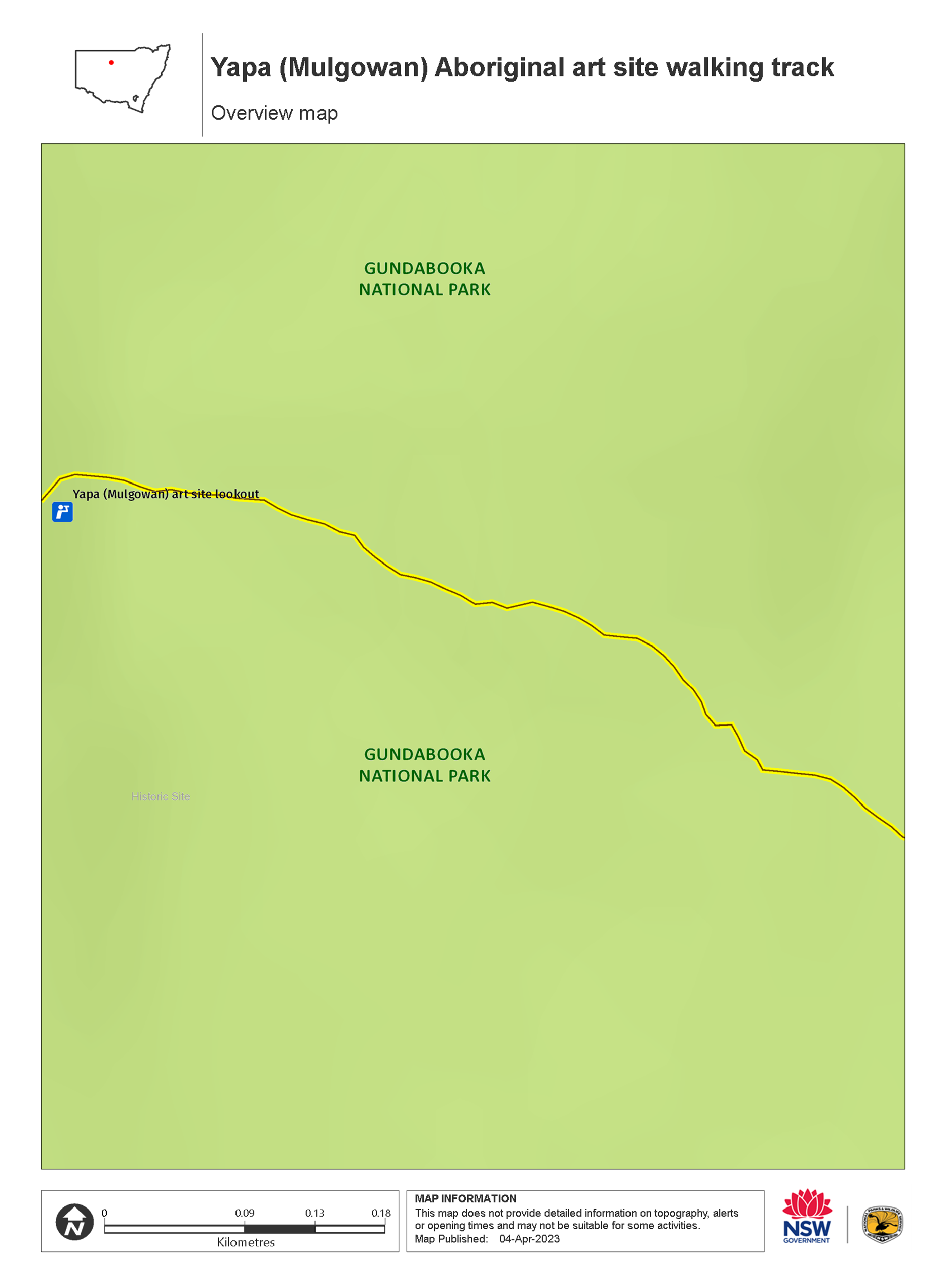
Local alerts
For the latest updates on fires, closures and other alerts in this area, see https://www.nationalparks.nsw.gov.au/things-to-do/walking-tracks/yapa-mulgowan-aboriginal-art-site-walking-track/local-alerts
General enquiries
- National Parks Contact Centre
- 7am to 7pm daily
- 1300 072 757 (13000 PARKS) for the cost of a local call within Australia excluding mobiles
- parks.info@environment.nsw.gov.au
Park info
- in Gundabooka National Park in the Outback NSW region
Gundabooka National Park is always open but may have to close at times due to poor weather or fire danger.
Visitor info
All the practical information you need to know about Yapa (Mulgowan) Aboriginal art site walking track.
Track grading
Features of this track
Distance
1.4km return
Time
45min - 1hr 15min
Quality of markings
Limited signage
Experience required
Some bushwalking experience recommended
Gradient
Very steep and difficult
Steps
Many steps
Quality of path
Rough track, many obstacles
Getting there and parking
On entering Gundabooka National Park from Kidman Way, 49km south of Bourke or 112km north of Cobar, drive along Ben Lomond Road for approximately 7.5km to the Mulgowan Heritage Site entrance on the left. Turn off, then drive for about 16km to the Mulgowan Heritage Site carpark.
Road quality
Check the weather before you set out as the road to Mulgowan (Yappa) Aboriginal Art site can become boggy when it rains.
Parking
Parking is available at Mulgowan Heritage Site.
Best times to visit
There are lots of great things waiting for you in Gundabooka National Park. Here are some of the highlights.
Autumn
It's a great time to visit the park with the weather being a bit cooler, and after summer rain, the park may be looking a little greener than usual.
Spring
Join in on a Discovery tour to find out more about the park, the amazing landscape and the animals who live here.
Winter
Crisp clear days await you, it's perfect weather for walking and if you don't feel like camping out, you can book into the comfort of Redbank Homestead.
Weather, temperature and rainfall
Summer temperature
Average
20°C and 33°C
Highest recorded
47°C
Winter temperature
Average
6°C and 17°C
Lowest recorded
-2.5°C
Rainfall
Wettest month
January and February
Driest month
June
The area’s highest recorded rainfall in one day
108.8mm
Facilities
Drinking water is limited or not available in this area, so it’s a good idea to bring your own.
Maps and downloads
Learn more
Yapa (Mulgowan) Aboriginal art site walking track is in Gundabooka National Park. Here are just some of the reasons why this park is special:
An emphasis on conservation
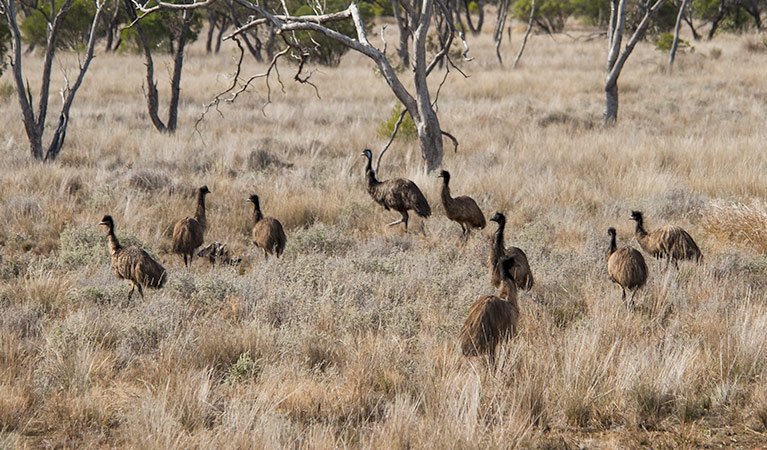
A visit to Gundabooka National Park offers the wonderful opportunity to spot some of Australia's rarest birds and animals. Several threatened species - including the little pied bat, kultarr, pink cockatoo and painted honeyeater - have been recorded in the area. The park also includes 21 different plant communities, including threatened plant species like the curly bark wattle.
- Little Mountain walking track Ideal for outback birdwatching and walking with kids, Little Mountain walking track offers a gentle walk with scenic views of Gundabooka National Park, near Bourke.
An important place
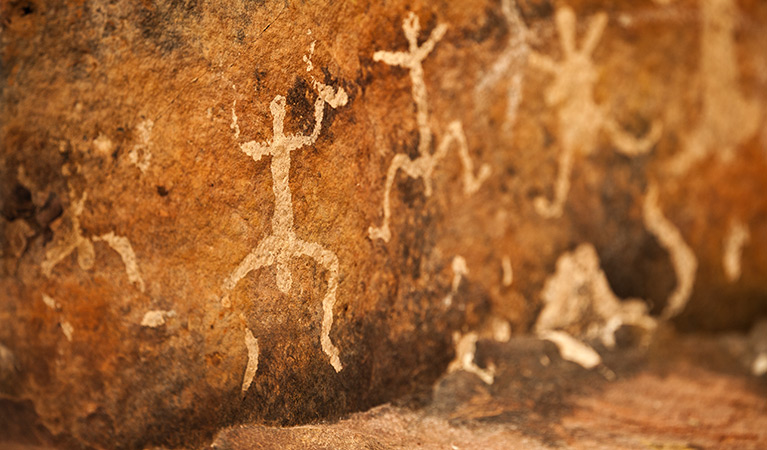
Gunderbooka range is highly significant to the Ngemba and Kurnu Baakandji people of western NSW. Before it became a national park, the area was home to the Ngemba and Kurnu Baakandji people of western NSW. Ceremonial events were held within the range. On your visit, you'll see Aboriginal rock art, with motifs including dancers and animals.
- Yapa (Mulgowan) Aboriginal art site walking track Yapa (Mulgowan) Aboriginal art site walking track offers a unique Outback experience with Aboriginal rock art and birdwatching in Gundabooka National Park, near Bourke.
Pastoral history
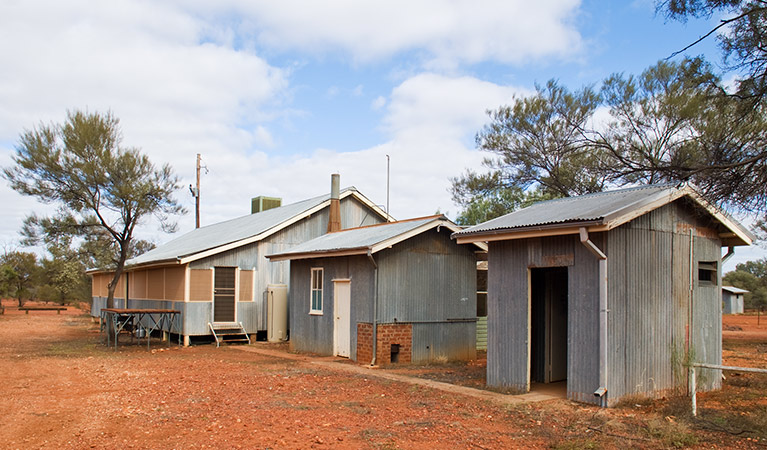
Though noted by Charles Sturt in 1829, the Gunderbooka range wasn't used by pastoralists until the late 1800s. The range was included in neighbouring sheep stations which were then subdivided after World War I. Today, three of these smaller stations - Ben Lomond, Belah and Mulgowan - make up Gundabooka National Park. Check out the old homesteads, quarters, fences, tanks, shearing sheds and yards on your visit.
Rewarding walks
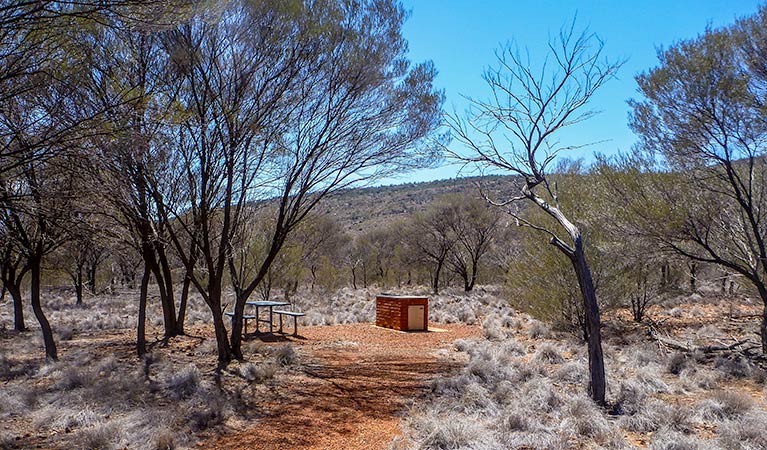
There are a number of opportunities to stretch your legs along one of the well-signed walks in Gundabooka National Park. Take the wonderful Mulareenya Creek Art Site track and see fascinating Aboriginal rock art. Walking the Little Mountain track is also well worth the effort with impressive views awaiting you at the summit.
- Bennetts Gorge picnic area Stop and relax at Bennetts Gorge picnic area when you visit Gundabooka National Park. Enjoy a barbecue or bring a picnic hamper before walking on to Mt Gunderbooka.
- Valley of the Eagles walk Valley of the Eagles walk starts at the popular Bennetts Gorge picnic area and explores the imposing Mount Gunderbooka in Gunabooka National Park.
The beautiful outback
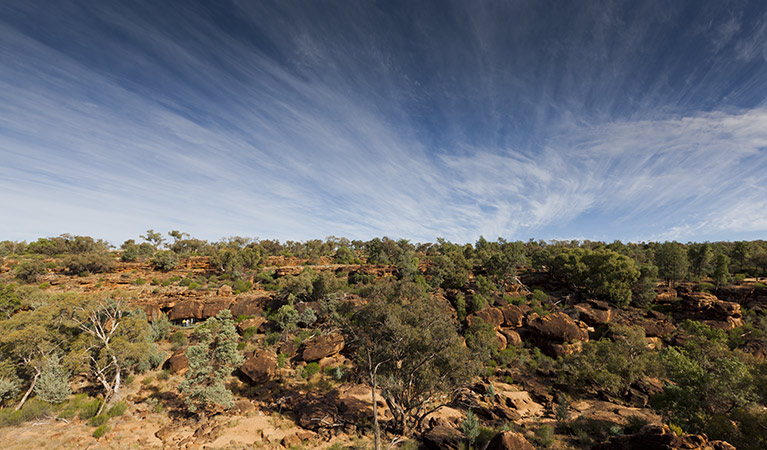
Gundabooka National Park is located in northwest NSW, approximately 50km southwest of Bourke and 110km northwest of Cobar. The 63,903ha national park extends from the Darling river banks to the Gunderbooka range. Vast stretches of grassy woodlands, open plains and rust-coloured rock dominate the landscape.
- Little Mountain walking track Ideal for outback birdwatching and walking with kids, Little Mountain walking track offers a gentle walk with scenic views of Gundabooka National Park, near Bourke.
Plants and animals protected in this park
Animals
-

Emu (Dromaius novaehollandiae)
The largest of Australian birds, the emu stands up to 2m high and is the second largest bird in the world, after the ostrich. Emus live in pairs or family groups. The male emu incubates and rears the young, which will stay with the adult emus for up to 2 years.
-

Wedge-tailed eagle (Aquila audax)
With a wingspan of up to 2.5m, the wedge-tailed eagle is Australia’s largest bird of prey. These Australian animals are found in woodlands across NSW, and have the ability to soar to heights of over 2km. If you’re bird watching, look out for the distinctive diamond-shaped tail of the eagle.
-

Red kangaroo (Macropus rufus)
The red kangaroo is one of the most iconic Australian animals and the largest marsupial in the world. Large males have reddish fur and can reach a height of 2m, while females are considerably smaller and have blue-grey fur. Red kangaroos are herbivores and mainly eat grass.
Plants
-

Mulga (Acacia aneura)
Mulga are hardy Australian native plants found throughout inland Australia. With an unusually long tap root, the mulga is able to withstand long periods of drought.

